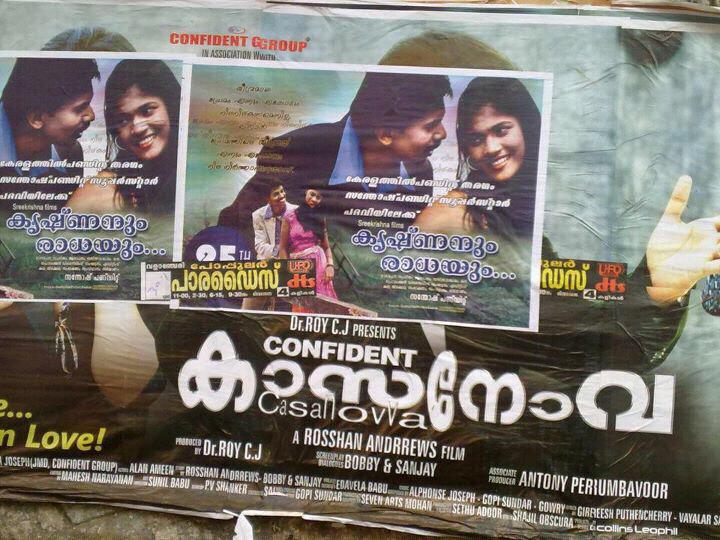This is the second research note from Darshana Sreedhar, one of the short-term social media research fellows at The Sarai Programme.
At the bi-annual Celebrity Studies conference in London this June, amidst hundred plus papers that ruminated on the modalities and meanings of stardom, surprisingly there were many researchers who were curious about the “Indian star” Pandit, who had a meteoric rise to become what one fan had described as “Kerala’s Justin Bieber” [1]. The flood of interest around the sudden popularity of Santosh Pandit following the success of his debut film Krishnanum Radhayum in 2011 had given him new epithets like the “Alien Star”, “Super Star of the Poor”, “YouTube Star” and so on, simultaneously ushering in debates on the aesthetic and technical worth of Pandit’s films.

My initial exposure to Pandit, like many Malayalis who are located outside Kerala was mainly through the virtual medium, particularly via the song sequence “Rathri Subharathri” [2] from the film Krishnanum Radhayum uploaded on YouTube in March 2011. I was also equally curious about this relatively new person who had suddenly grabbed his “fifteen minutes of fame” in an uncannily Warholian fashion [3]. Pandit, however lasted longer than that by utilizing the potential opened up by the democratization of the regime of image production, circulation and consumption enabled by the digital revolution and the Internet. Till the release of the song sequence on YouTube, the name Pandit was unknown even to the most avid film enthusiasts in Kozhikode, the place from where he hails. Except a few who knew him as an enthusiastic man in his forties who was struck by the cinema-bug and attempted to make a few albums, no one had any clear memory of his talents exhibited otherwise. But, in no time he mobilized a huge fan following and a strong virtual presence through fan pages and other promotional material so much so that he became a regular presence as chief guest at several college fests and business inaugurations throughout Kerala.
Pandit’s debut film Krishnanum Radhayum went on to bag theatrical release in October 2011, simultaneously releasing in more than ten theatres, which was an unforeseen event. The theatrical exhibition of the film was a spectacle in itself, with the young all-male crowd jeering and shouting out all kinds of sexually colored expletives directed at both Pandit and the actresses. This, as one reviewer [4] of the film puts it was reminiscent of the Bharanipattu or Theripattu (song of expletives) [5] the religious ritual at the Kodungaloor Bharani, a month long festival in the month of March where the devotees hurl abuses at the Goddess. Interestingly, this was followed by the successful release of the audio and DVD copies of the film which came as an utter shock to the film pundits who had written off Pandit as a nobody whose films did not even merit mention at the box-office collection. Despite this, it became clear that the Pandit Phenomenon was here to stay and it was after his second film Super Star Santosh Pandit or Jithubhai Enna Chocolate Bhai (2012) that he gained the epithet of “Superstar of the Poor.” Pandit went on to make more films such as Minimolude Achan (2014) and most recently Kalidasan Kavita Ezhuthunnu (Forthcoming).
But responses to Pandit were not all laudatory — there were acerbic attacks on him both on and off the web, also culminating in several physical attacks, being manhandled and pelted with stones and eggs. Allegations against Pandit’s films ranged from being seen as addressed to the unconscious and unrealized desires of the audience, as a vehicle to satisfy the masochistic need of Malayalis and as a weed which has to be removed at the budding stage.
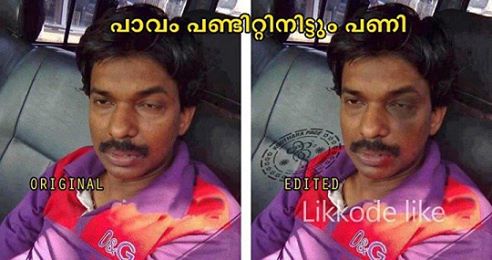
It was not the first time that YouTube songs catapulted the interest of the viewers through negative publicity. For instance in 2011, Malayalam album titled Silsila Hai Silsila [6] released by Harikrishnan was subjected to quite a lot of negative comments and was tagged as the worst Malayalam album ever [7]. But, unlike Harikrishnan who put an end to his singing career after such comments, Pandit used such criticism as a chance to retort to his critics in equally sarcastic and witty ways, thereby mobilizing more “views.” “If Krishnanum Radhayum hit one lakh views only after 13 days, my latest film Minimolude Achan went on to make the one lakh views in just 6 days, but still I do not want to be known only as an Internet celebrity. It delimits me into one category,” Pandit said [8].
Curiously, the negative wave of comments and critiques against Pandit gave him more viewers who wanted to watch Pandit’s song sequences to understand the “despicable levels to which Malayalam cinema has stooped” [9]. Alongside the content of the films which were seen as lacking seriousness and rigour, what had terribly shaken film aficionados was the popularity Pandit attained in quite a short time, amidst the backlash against him from the industry for whom he was just a mere komali (joker). Whether it is through his seemingly ironic use of negative publicity, or the reprehensible attacks against him by media-personalities or his own or his tongue-in-cheek responses to them, Pandit gave full credence to the titles of “YouTube star” or “Superstar of the Poor” — positive epithets which he was showered with alongside the equally despicable abusive comments which peppered the YouTube links to his films.
The stardom which Pandit achieved was of a peculiar kind and was remarkable because of the ways the audience, both the virtual and real, made use of the label of “Pandit”, making his foray into cinema stand for a large array of causes. For instance, Pandit was seen as the savior of Kerala in a fan-poster when the Mullaperiyar issue with Tamil Nadu was festering and Pandit was also seen distributing rice and other eatables to the tribal community in Attapady in real-life [10].

In another actual instance, Pandit’s full-time job as an overseer in the Irrigation Board landed him a position as a polling officer during the General Elections this year, which turned even the polling-booth into a mini-spectacle with crowds thronging not only to vote to also glimpse the “Superstar of the Poor”.
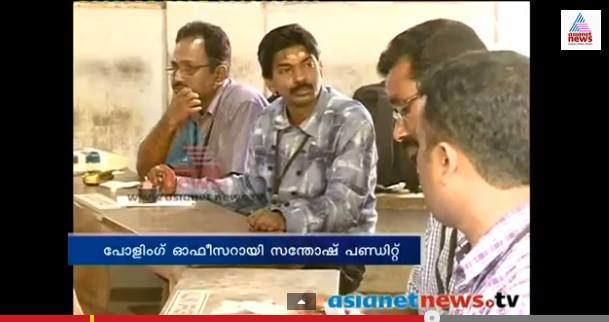
This epithet “Superstar of the Poor” is particularly crucial as it lends Pandit with an air of everydayness and the sense of an ordinary man donning the garb of a star. If Pandit is the “Superstar of the Poor” perhaps the Internet that is known to Pandit and his fans/abusers is equally an Internet of the Poor.

Pandit’s tag as a “regional celebrity” soon turned into a hit search term when the Google statistics on 12th November 2011 had Santhosh Pandit ranked at No. 2 on Google Trends [11], second only to social networking giant, Facebook. In spite of its overwhelming propensity to welcome artists outside the regional boundaries of Kerala to test their luck in Malayalam cinema, the film industry however, has been cold to Pandit’s ventures. With his nerdy looks and dark complexion not befitting the normative film “star” and his self proclaimed all-rounder tag which allowed him to take up roles as varied as the hero, production manager, sound recordist, editor, lyricist and stunt master, Pandit’s entry was an anomaly to the hitherto practiced modes of film production in Malayalam cinema.
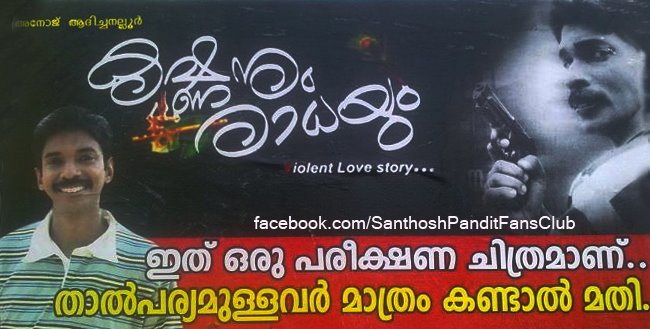
For instance, bitter remarks were directed at Pandit’s daringness for having attempted to don “manly” roles and romantic song sequences — “manliness” of course, having to do with the action-hero aggressiveness of Suresh Gopi, Prithiviraj’s chiseled, chocolate hero features or Mohanlal’s fair complexion. Often, Pandit has also been at the receiving end of casteist abuses for the same reasons.
While “aesthetic masculinity” forms one end of the spectrum, attacks on Pandit have also accrued from his status as an ostensible “threat” to the industry, as he has been seen as oversimplifying film production and popularizing low-budget techniques.
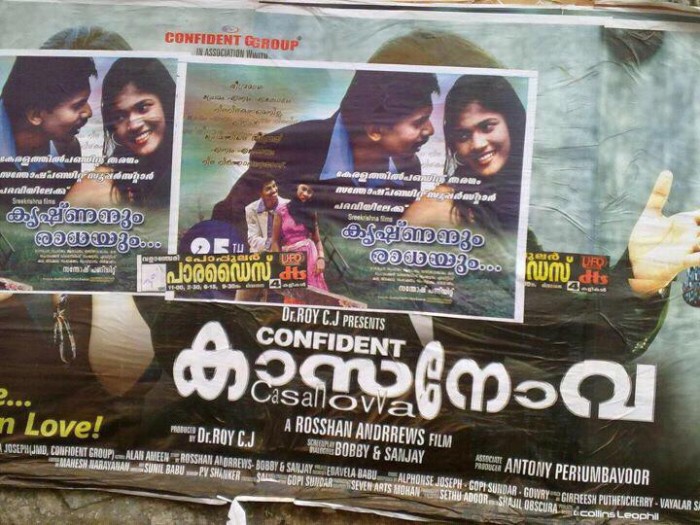
In fact, Pandit’s initial foray into cinema was fuelled by his desire to enact his own script and to work out the nitty-gritties of low budget production. Starting with the basics of video editing, he slowly started to experiment with other technical aspects of digital film production. Ironically though, his amateurish experiments with technology and the film form, Pandit’s films were in many ways vaguely similar to many mainstream Malayalam films which had continued with the formulaic treatment of themes, charged dialogues, melodramatic excess and predictable narrative patterns.
The emergence of Santosh Pandit as an Internet celebrity opens out new questions on how Malayalam cinema has made use of the tag of “super-star.” By the sheer virtue of being an outsider of sorts, Pandit upsets the conventional expectations and screen presence which has been associated with stardom in Malayalam cinema. Pandit’s popularity has also led to his presence in a few Mappila (Muslim) albums [12] and home-videos which are not produced by him and an Internet talk-show named the “Santosh Pandit Show” ruminating on current affairs is also rumoured to be under way. If the film industry and critics have maintained a parochial attitude towards the Pandit Phenomenon, Santosh Pandit has displayed great acumen in utilizing the potentials of the digital medium. Perhaps nothing sums up Pandit’s continuing durability than a dialogue from Krishnanum Radheyum which has become an Internet meme as well: “Only because you think you are big, doesn’t mean I need to perceive myself as small” [13].
Notes
[1] MOVIEWORLD MOVIECHANNEL. 2013. Super Star Santhosh Pandit In Chiranjeevi IPS (Krishnanum Radhayum Fame) [HD]. April 29. Retrieved from https://www.youtube.com/watch?v=gkPU17Dt2zM.
[2] Siby Baisil. 2011. Rathri Shubharathri Santhosh Pandit. March 16. Retrieved from https://www.youtube.com/watch?v=udHd86T1Tas.
[3] There are other articles as well which have attempted to look at the Pandit phenomenon. For instance, see, Sivaram Srikandath’s ‘The Curious Case of Santosh Pandit,’ where the author attempts to know who Pandit is after he sees the overwhelming number of negative comments against him (Srikandath, Sivaram. 2011. The Curious Case of Santosh Pandit. Manorma Online. November 16. Retrieved from http://www.manoramaonline.com/cgi-bin/mmonline.dll/portal/ep/contentView.do?contentId=10441155&channelId=-1073865029&programId=1080133016&BV_ID=@@@.).
[4] Mathrubhumi. 2011. Krishnanum Radhayum: Arachakatvam srishtikkunna armadham. October 22. Retrieved from http://www.mathrubhumi.com/movies/review/224033/#storycontent.
[5] killikulangara,com. 2010. KODUNGALLUR BHARANI PAATTU -PART 1.wmv. April 24. Retrieved from https://www.youtube.com/watch?v=aUdT6Sxw6qI.
[6] Harisankar Kalavoor. 2012. SILSILA HAI SILSILA, MALAYALAM ALBUM (OFFICIAL). By and © Harisankar Kalavoor. August 07. Retrieved from https://www.youtube.com/watch?v=EunwnU6vg1Q.
[7] Venkiteswaran, C.S. 2011. Santosh Pandit Nalkunna Padangal. Mathrubhumi Weekly.
[8] Telephonic Interview with Pandit taken by author on July 23, 2014.
[9] ukmalayalee. 2011. Nikesh Kumar’s disastrous interview with Santhosh Pandit. October 31. Retrieved from http://ukmalayalee.com/latest-news/news.php?id=Mjc4OQ==.
[10] Gayathry. 2013. Santosh Pandit Turns Superstar in Real Life. One India. August 6. Retrieved from http://entertainment.oneindia.in/malayalam/news/2013/santhosh-pandit-turns-superstar-real-life-116530.html.
[11] D’ souza, Shawn. 2011. Santosh Pandit: India’s Answer to Gaga. Digi-Mouth. November 14. Retrieved from http://www.digimouth.com/news/santhosh-pandit-indias-answer-to-gaga-bieber.html.
[12] Cinecurry. 2012. Santosh Pandit’s Mappila Lahala Song. March 13. Retrieved from https://www.youtube.com/watch?v=-2pcjvgpBWk.
[13] shafeedh sa. 2011. Krishnanum Radhayum Official Trailer (Exclusive) – Santhosh Pandit Punch Dialogues. July 31. Retrieved from https://www.youtube.com/watch?v=p5QY5RJHQa4.
